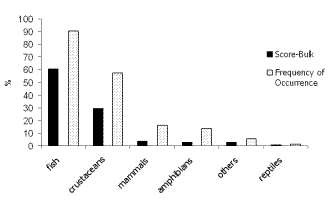 |
Last Update:
Thursday November 22, 2018
|
| [Home] |
INTRODUCTION Otter dietary studies are useful in determining how species deal with ecological changes in prey populations and habitat availability (Anoop and Hussain, 2005). Analysis of scats is still widely used for this purpose, despite some caveats. Kruuk (2006) cautioned that, with the scat analysis, one can only obtain a rough ranking of the importance of prey taxa in otter diet, but without accurate estimates of percentual composition of each prey category. Unfortunately, for the Neotropical otter (Lontra longicaudis) there are not many alternatives. Kruuk (2006) points out that the most reliable method to study otter diet is by direct observation. For L. longicaudis, however, the application of such a technique would be very difficult due to its nocturnal habits in most of its range, which could hinder not only the observation of animals but also the identification of their prey. A large proportion of all studies published until recently on this species is limited to its feeding habits, most of them merely listing prey taxa and frequency of occurrence (Waldemarin, 2004). The use of scats for studying L. longicaudis diet has the advantage that there is no need to sacrifice or to disturb the animals (Wise, 1980). It is also an easy method, since Neotropical otters defecate in conspicuous places (Waldemarin, 2004; Kasper et al., 2004), making it simple to collect an adequate sample size of feces. Frequency of occurrence (FO) is the most commonly used method to assess diet from carnivore scats (Neale and Sacks, 2001), but it is known that it can provide biased results (Carss et al., 1998). Results may underestimate the importance of bigger prey, and overestimate smaller prey (Roser and Lavers, 1976). Besides, the occurrence of a single item and occurrences of several similar items will both have the same weight in the analysis (Carss, 1995; Neale and Sacks, 2001). Thus, frequently consumed prey can be underestimated, because even if fragments of several individuals are found together in a single fecal sample, they will still count as a single occurrence (Zabala and Zuberogoitia, 2003). Captive trials, in which a diet of known composition (in species and weights) was given to minks, showed that frequency of occurrence did not provide a reliable estimate of the food ingested (Wise et al., 1981). In the literature, there are not many studies indicating statistical concerns, such as calculating confidence intervals for the categories of prey (Carss, 1995). Despite these limitations, the frequency of occurrence method is able to provide the estimates of seasonal and spatial variation in the diet of otters (Spinola and Vaughan, 1995; Soldateli and Blacher, 1996; Helder and Andrade, 1997; Pardini, 1998; Utreras et al., 1998; Quadros and Monteiro-Filho, 2001; Rheingantz, 2006; Waldemarin, 2004). Another method to study diets, which has seldom been used for otters, is the score-bulk estimate (SBE) (Wise et. al., 1981). SBE is a relative volumetric method based on a scale of scores which are visually attributed to the quantity of each category in each sample. SBE has the advantage of taking in account the amount of each food item which is present in each sample. In general, the weight or volume of prey in scats gives a more reliable result, but frequency of occurrence can be accurate to rank the importance of prey categories (Wise et al., 1981; Carss and Parkinson, 1996; Anoop and Hussain, 2005). On the other hand, SBE can be more time-consuming than FO, and there is some degree of subjectivity involved in visually estimating the scores. Our study aims to compare two different analytical methods, (1) FO and (2) SBE, to assess the diet of the Neotropical otter from fecal samples: the frequency of occurrence method and the score-bulk method (Wise et al., 1981). Rather than trying to point out which of them would be the best method, we intend to discuss the advantages and disadvantages in each of them, evaluating how much difference there is between their results. Additionally, we propose a new index combining both methods. STUDY AREA AND METHODS Otter scats were collected at Mambucaba River Basin, southeastern Brazil. At the laboratory, samples were washed in flowing water on a 1mm mesh sieve, and dried for 48 hours in an oven at 40 oC. After drying, non-digested food items (scales, bones and exoskeletal elements) were identified and placed in one of the following categories: insects, crustaceans, amphibians, reptiles, fish, birds or mammals. Unidentified items were included in the "others" category. Subsequently, the items were analyzed using the two methods. With FO, the presence or absence of a certain category was recorded in each fecal sample, and the results were expressed as the percentage of samples which had that category in relation to the total number of samples, that is:
In the SBE method, a score, from 1 to 10, is visually attributed to the quantity of each category in each sample (total score for one scat is 10). Each score was multiplied by the dry weight of the sample, and these results (SBE) were summed for each sample which had a given category. Finally, estimates were expressed for each category as the percentage of SBE of that category in relation to the sum of SBEs of all categories, that is:
The correlation between the rank orders of prey categories (from the most to the least consumed), obtained by the two methods, was calculated by Spearman rank correlation, using the software Statistica 6.0 (Statsoft Inc., Tulsa, OK, USA). RESULTS We analyzed 73 scat samples. Fish was the item most consumed by otters, according to both methods. In terms of FO, we found fish in 90.4%, crustaceans in 57.5%, mammals in 16.4%, amphibians in 13.7%, non-identified material in 5.5% and reptiles in 1.4% of the samples. Using the SBE, the proportions were 60.9%, 29.3%, 3.5%, 2.9%, 2.7% and 1.0% respectively (Figure 1). The percentages are not comparable between methods, since for SBE the sum of percentages is always equal to 100%, while for FO it is more than 100%, as two or more taxonomic categories can occur in one fecal sample. Nevertheless, the rank order of categories, from the most to the least frequent, was identical for the two methods (Spearman rank correlation, rs=1, P<0.01).
DISCUSSION At least in the present work, the rank order of categories was identical for the two methods, but it can be seen that the differences between percentages were higher with the score-bulk method (Figure 1). In studies with other otter species, SBE gave a more reliable result, showing with more accuracy the proportion of prey than the FO (Wise et al., 1981; Jacobsen and Hansen, 1996; Carss and Parkinson, 1996; Anoop and Hussain, 2005). However, the rank order of categories is usually the same for both methods (Wise et al., 1981; Jacobsen and Hansen, 1996; Anoop and Hussain, 2005). A problem that may be found is that the different prey categories may have different degrees of digestibility (Putnam, 1984; Zabala and Zuberogoitia, 2003), so that quantity and volume of non-digested parts that are eliminated may vary, according to the kind of prey. For example, different prey categories are likely to present different surface area / volume relations, which may influence digestibility. Besides, animals which have rigid digestion–resistant exoskeletons, such as the crustaceans, could be overestimated. However, in this study, crustacean importance, as estimated by SBE, was not high, probably due to the many fish scales and bones found on the scats. The parts of fish eaten by Neotropical otter in this study had many big scales and bones, increasing the importance of the “fish” category on SBE. The advantage in using a method like the SBE is to establish a more realistic relationship between the smaller and bigger fragments of prey (Wise et al., 1981; Jacobsen and Hansen, 1996). We conclude that the most viable recommendation for dietary studies would be an index combining two or more analytical methods, one volumetric, such as SBE, and the other frequency-based, such as FO. This could combine the information of how frequently a certain prey taxa is consumed with how much it is consumed, offering then a more overall view of the feeding habits. Therefore we suggest such an index, the Rescaled Importance Index (RII), as follows.
It is useful to rescale Ii by dividing it by the sum of I’s for all prey categories; the result is the Rescaled Importance Index for each category (RIIi):
In this way the result, RIIi now varies from 0 to 1. This index expresses the importance of each prey category in a single value, taking in account both its frequency and its volume. An useful property of RII is that:
This property allows that the RIIi can be meaningfully compared with the RIIi for that same category in other studies, carried out at different places or with different species. Therefore we suggest this index can be useful for comparing diets in studies on otters and other species as well. ACKNOWLEDGMENTS - We would like to thank "Hotel do Bosque" and “Associação Ecológica Ecomarapendi” for the logistic support, Helen Waldemarin and Erica Caramaschi for the supervising, CNPq for financial support, and all the colleagues of Laboratório de Ecologia e Conservação de Populações/UFRJ. Two anonymous reviewers provided constructive criticism that contributed to improve the quality and content of the paper. REFERENCES Anoop, K.R., Hussain, S.A. (2005). Food and feeding habits of smooth-coated otters (Lutra perspicillata) and their significance to the fish population of Kerala, India. J. Zool., London 266: 15–23. Résumé : Comparaison De Deux Méthodes Différentes Visant À Estimer Le Régime Alimentaire De La Loutre À Longue Queue (Lontra longicaudis) Avec Proposition d'Un Nouvel Index Pour Ce Type D'études Resumen: Comparación De Dos Métodos Diferentes Para Estimar La Dieta De La Nutria Neotropical De Río, Lontra longicaudis, Y La Proposición De Un Nuevo Índice Para Los Estudios De Dieta. |
|||||||||||||||||||||||||||||||||
| [Copyright © 2006 - 2050 IUCN/SSC OSG] | [Home] | [Contact Us] |





